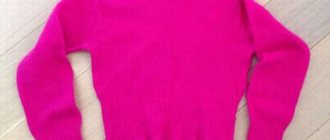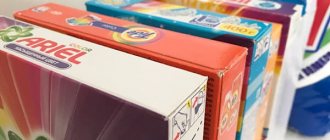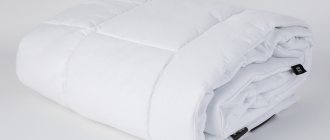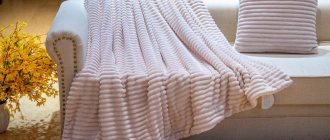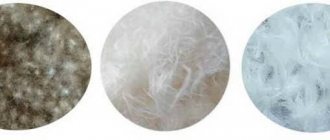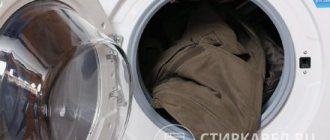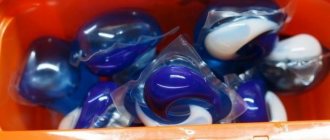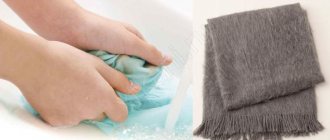Features of clothing with a membrane
The membrane material was invented back in 1969 by American inventors and was called Gor-Tex.
Currently, depending on the purpose, membrane clothing comes in several types:
- casual;
- professional;
- for active recreation (Gor-Tex Active).
Its design depends on the purpose of the clothing. Usually this is 2, 3 or 2.5 layers. The membrane itself, which is a thin film with micropores, is attached to the base or located between layers of fabric. The pores are very small, they do not let moisture in from the outside, but with great physical activity they easily remove sweat from the body to the outside.
A wear-resistant coating is used as the top layer, which is additionally treated with a special composition that repels water.
This type of outerwear has the following positive characteristics:
- does not allow moisture to pass through from the outside, but allows the skin to “breathe”;
- protects from wind;
- keeps warm;
- is light and durable.
Along with this, there are also disadvantages:
- High price
- Relatively short service life
- Special requirements for product care
Advantages and disadvantages of membrane clothing
Many adults believe in miracles; they believe that if they purchased an expensive membrane item, it will solve all their problems and will work in any conditions. They are especially indignant when children's overalls are purchased with the hope that their children's underwear will not become wet during active play outside and they will not freeze in frosty weather.
Let's remember the advantages of this clothing:
- The membrane item ideally protects from snow and rain, and gusts of wind.
- Lightweight - you really want to jump and gallop in it, enjoying a walk in the fresh air.
- Warm without any insulation - your body heats itself, the membrane prevents cold air from penetrating inside.
- Saving time and nerves - it is now much easier to send a child for a walk, there is no need to put several layers of clothes on him. And the child will not sweat, waiting for you while you get dressed.
- Due to the water-repellent film on the surface, dirt does not absorb into it; it is enough to simply wipe it with a sponge.
And now about the other side of the coin. The disadvantages of this mega popular clothing include the following:
- High cost - no comment.
- Special care is required: delicate washing and further impregnation with special sprays.
- Retains its unique properties for only a few seasons.
- You cannot wear regular underwear under it; the costs include purchasing thermal underwear and fleece items.
Having weighed all the pros and cons, the conclusion is obvious - everyone should have a membrane item. You just need to learn how to wash membrane clothes and understand how to properly care for them.
Detergents for washing membrane fabrics
Choosing the right and high-quality membrane washing agent is very important. Using the first thing that comes to hand, you can simply ruin an expensive item.
A common question among owners of such things is: can the membrane be washed with regular powder? The answer is categorical - no, it will not work, the film does not tolerate sulfates and phosphates, which are present in large quantities in detergents of this type. In addition, the pores of the membrane will become clogged with powder particles, and it will lose its protective properties.
Recommended products
- The easiest way is to wash clothes with laundry soap. It dissolves well in water and removes dirt from the fabric. The soap is grated, and the resulting fine shavings are dissolved in water without any residue.
- Shampoo, for example, Salton Sport and Domal Sport. This is a certified cleaning product for sportswear with climate membranes. For one wash, the manufacturer recommends using 20-25 ml of liquid. You can buy them in sports stores, along with clothes.
- Special gel, for example, Denkmit Fresh Sensation. When washing in an automatic machine, it is poured into the dry powder compartment. This product does not damage the fabric and takes good care of the membrane. In addition, it gives clothes water-repellent properties.
- Nikwax tech wash liquid soap for membrane. An effective product that removes even heavy dirt and residues of other detergents. It is recommended to use in tandem with impregnation of the same series, strictly following the instructions.
- According to user reviews, gel-con for the membrane will only cope with minor stains and get rid of unpleasant odors.
Advice! If you do wash the membrane with powder or gel containing sulfates, do not despair. Treat it with aerosol impregnation and henceforth use only suitable products.
What should not be used for washing?
In addition to washing powder, the following products are prohibited:
- containing chlorine. They significantly expand the micropores of the membrane, as a result of which it retains moisture from the external environment worse. In addition, chlorine, even in the lowest concentrations, can dissolve water-repellent impregnation;
- any bleaches and stain removers. They act on membrane products in the same way as chlorine.
- You shouldn't use fabric softener either. They give things a pleasant smell, but degrade the quality of the membrane.
Advice! It is not necessary to wash the entire item; you can often wipe away stains with a sponge and laundry soap or dishwashing detergent.
Since membrane products require very careful handling, it is best to wash and tidy them yourself rather than take them to the dry cleaner. After all, the client has no way to track which product the dry cleaning staff uses. It will be very difficult to prove that the item was damaged.
Care of membrane tissues
Membrane fabric consists of several layers (at least two): a regular (most often synthetic) base and a thin “film” applied to its reverse side - the membrane itself.
Manufacturers almost always treat base fabric with DWR water-repellent impregnation. Thanks to this impregnation, water does not wet the fabric, but rolls off it in droplet balls. This reduces the load on the membrane and also has a positive effect on the appearance of the product: it remains dry even from the outside. However, DWR impregnation “washes out” or wears off during use. This does not affect the properties of the membrane itself (that is, it continues to properly protect against moisture and “breathe”), but it does affect aesthetics: in places where the DWR has been “washed out,” the main fabric gets wet—wet spots appear, and it seems that the product is wet through. It’s not difficult to combat this: just purchase DWR impregnation and treat the product.
It is advisable to wash membrane fabrics as rarely as possible. Therefore, it is better to remove “non-greasy”, “not ingrained” dirt in the following way: wait for the stain to dry and simply wipe it off, shake it off with a brush or cloth, often it is enough to simply shake off the slightly dried dirt with your hands. The main thing is not to rub dirt into the pores of the fabric, but to shake it off or wash it off.
IMPORTANT! If you just shake it off with your hands as soon as the dirt dries, you can get by with one wash per season. If you postpone this procedure “until tomorrow,” it may be more difficult to do.
How to properly wash membrane clothes?
Contrary to existing myths, modern clothes with membranes must be washed. If this is not done, the pores will become clogged with dust and dirt, and the protective properties of such material will decrease.
Washing a jacket or other large item with a membrane can be done by hand or in a washing machine. But it has its own rules and features:
- Before washing, be sure to study the manufacturer's recommendations on the label.
- Use suitable detergent.
- Do not treat fabric with bleaches or stain removers.
- It is not recommended to soak clothes with a membrane.
- Wash at low temperatures, no more than 40°C. At high. temperatures, the pores of the membrane will simply stick together and it will stop working.
- Rinse thoroughly to ensure no streaks remain after drying.
- After washing, dry the product properly.
You also need to prepare your clothes: empty your pockets, remove small debris from them, fasten all buttons and zippers, unfasten the fur. To avoid damage to buttons and other fragile accessories, they are sealed with tape.
Machine washable
As with washing down jackets, membrane clothing has its own rules and restrictions when machine washing. To successfully wash such items in a washing machine, you need to follow the following algorithm:
- Place the product in the drum. It is advisable to wash large items one at a time - a jacket separately, trousers separately.
- Pour in a high-quality detergent; washing powder is completely eliminated.
- Set the most gentle mode, optimally manual or delicate. The maximum permissible temperature limit is 40°C. This is very important, since the membrane will deteriorate in hot water, and it will be impossible to restore its functional qualities.
- Set to double rinse.
- Press only by hand without twisting. You cannot use a machine spin, as this can destroy the outer water-repellent layer.
- Wet items must be dried properly.
Handwash
Items made from membrane fabric can be easily washed without a machine, by hand. In this case, the risk of damaging the membrane will be lower.
Here's how to proceed:
- Prepare a bowl of warm or cool water. Temperature is critical. Just as in the case of an automatic machine, it should not exceed 40°C, the optimal option is 30-35°C. The container should be voluminous so that you don’t have to wrinkle the clothes too much.
- Dissolve the chosen product well in water.
- Place the product in water and wash it very carefully. If there are stains on the surface, you can get rid of them by rubbing with a brush and baby or laundry soap.
- Rinse the items twice and, as a final step, give them a cool shower.
- Dry the product.
RIGHT:
- Before washing, pre-fasten zippers, buttons and adhesive fasteners. Turn the clothes inside out.
- Wash with liquid detergents WITHOUT bleach or special detergents for washing membrane fabrics. CARE PRODUCTS FOR PRODUCTS MADE FROM MEMBRANE FABRICS ARE ESSENTIAL FOR EXTENDING THE SERVICE LIFE OF PRODUCTS.
- The membrane does not require frequent washing. Most dirt can be removed with a damp cloth or sponge immediately after a walk. If washing is necessary, choose a delicate cycle, without spinning and drying, at temperatures up to 40°C (see icons on the product). Water temperatures above 40 degrees will seal the pores.
- Membrane items love space, that is, you should not load several wardrobe items into the drum at once. If the item is large (for example, overalls), then it must be washed separately from others.
- Dry at room temperature. Membrane clothing with modern insulation dries very quickly. The item must be straightened.
Proper drying
Drying clothes with a membrane also needs to follow certain rules. Compliance with them will help extend the life of things.
- Do not twist under any circumstances. You can hang the jacket by the shoulders to drain excess moisture, and then gently, without twisting movements, squeeze it out with your palms.
- Wrap the product in a large towel or an unnecessary old sheet. This will also help absorb excess liquid.
- When the fabric is soaked, lay the jacket or trousers on a hard, horizontal surface. It should be covered with a dry cloth, which needs to be changed as it gets wet.
The room in which things are dried should be well ventilated. It is strictly forbidden to dry clothes on hot radiators and heaters, or to iron them. After the items have dried, they are treated with impregnation.
Impregnation of clothes
The top layer is impregnated at the production stage. The water-repellent composition allows the fabric to always remain dry. But over time, after 4-5 washes, this composition is gradually washed out, and the top layer of clothing gradually allows moisture to pass through.
To prevent this from happening, you need to process the clothes yourself. Impregnation for membrane clothing can be purchased in the form of liquid products and aerosol sprays.
Advice! When choosing a product, it is better to consult with the seller which one is suitable for your clothes.
When using liquid, you need to prepare a solution and rinse your clothes in it. The manufacturer indicates the ratio of liquid impregnation and water in the instructions for use. It must be strictly followed. The aerosol product is simply sprayed evenly onto the fabric. The frequency of use for a liquid product is once every 2-3 washes, for an aerosol - once a month, if the item is used actively, or less often.
Attention! Excessive and frequent use of impregnation clogs the pores in the membrane and reduces its properties.
In any case, the procedure is carried out only after washing. It should be taken into account that after repeated application of impregnation, the color of the product may change.
How to care for membrane clothing?
Regular care of membrane clothing is very important. This determines how long the product will last.
The following recommendations will help increase their lifespan:
- It is necessary to wash clothes with a membrane when they become dirty. Recommended frequency 1-2 times per season, depending on the frequency of use.
- You need to store such things in a closet, as they easily absorb foreign odors - food, tobacco smoke, perfume.
- The storage area for membrane products should not be damp. It is advisable that it be clean and well ventilated.
How to dry washed clothes
After the question: “How to wash a ski jacket?”, another one arises: “How to dry it?” After washing, be sure to dry the product. To do this, lay out the washed membrane clothing in a horizontal position at room temperature and with good ventilation. Do not dry products near a radiator or fire, as they may cause the film to burn out. In order to preserve the impregnation, avoid direct sunlight. They can evaporate it. You should not iron the fabric either. This can damage the membrane, melt the synthetic fabric and permanently damage the product. If ironing is necessary, use a steam generator.
Membrane clothing is very convenient and comfortable to use, but caring for it can seem very difficult. Actually this is not true. Washing membrane clothing is quite simple; The main thing to remember is that things are washed one at a time, you need to use special products and you shouldn’t wring out membrane items. Following simple rules will save you from damage to the product.



